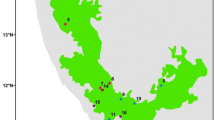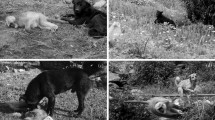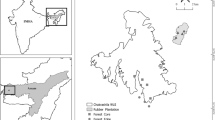Abstract
Data from 24 wild populations of hanuman langurs (Presbytis entellus)in south Asia are used to test hypotheses seeking to explain variation in troop structure and the incidence of infanticide. The occurrence of infanticide is associated with a one-male troop structure and not with a high density. The density, predation, and economic-advantage hypotheses, as explanations for the occurrence of one-male and multimale troops, are not supported by the review. However, the monopolization hypothesis is not contradicted; the number of adult males per troop is significantly correlated with troop size and with the number of adult females per troop. Therefore it is suggested that a one-male troop structure will arise if a male is able to monopolize a group of females, a multimale troop if he cannot. One-male troops may predispose to infanticide because of high variance in male mating success and high intermale competition between groups rather than within troops. If female dispersion determines troop structure, it is speculated that females could manipulate males to form a multimale society if the advantages in terms of infant survival and intertroop conflict exceeded the costs in terms of not producing infanticidal “sexy sons.”
Similar content being viewed by others
References
Agoramoorthy, G. (1986). Recent observations on 12 cases of infanticide in hanuman langurs,Presbytis entellus, around Jodhpur, India.Primate Rep. 14: 209–210.
Alatalo, R. V., and Lunberg, A. (1986). The sexy son hypothesis: Data from the pied flycatcherFicedula hypoleuca.Anim. Behav. 34: 1454–1462.
Aldrich-Blake, P. (1970). Problems of social structure in forest monkeys. In Crook, J. H. (ed.),Social Behaviour in Birds and Mammals, Academic Press, New York, pp. 79–101.
Alexander, R. D. (1974). The evolution of social behavior.Annu. Rev. Ecol. Syst. 5: 325–383.
Andelman, S. J. (1986). Ecological and social determinants of Cercopithecine mating systems. In Rubenstein, D.I., and Wrangham, R. W. (eds.),Ecological Aspects of Social Evolution, Princeton University Press, Princeton, N.J., pp. 201–216.
Angst, W., and Thommen, D. (1977). New data and a discussion of infant-killing in Old World monkeys and apes.Folia primatol. 27: 198–229.
Bishop, N. H. (1979). Himalayan langurs: temperate colobines.J. hum. Evol. 8: 251–281.
Bishop, N. H., Hrdy, S. B., Teas, J., and Moore, J. (1981). Measures of human influences in habitats of South Asian monkeys.Int. J. Primatol. 2: 153–167.
Boggess, J. (1979). Troop male membership changes and infant killing in langurs (Presbytis entellus).Folia primatol. 32: 65–107.
Boggess, J. (1980). Intermale relations and troop male membership changes in langurs (Presbytis entellus) in Nepal.Int. J. Primatol. 1: 233–273.
Boggess, J. (1984). Infant killing and male reproductive strategies in langurs (Presbytis entellus). In Hausfater, G., and Hrdy, S. B. (eds.),Infanticide: Comparative and Evolutionary Prespectives, Aldine, New York, pp. 283–310.
Burton, G. J. (1981). The relationship between body and gonadal weights of the dusky leaf monkey (Presbytis obscura).Int. J. Primatol. 2: 351–368.
Butynski, T. M. (1982). Harem male replacement and infanticide in the blue monkey (Cercopithecus mitis stuhlmanni) in the Kibale Forest, Uganda.Am. J. Primatol. 3: 1–22.
Chalmers, N. (1979).Social Behaviour in Primates, Arnold, London.
Chapman, M., and Hausfater, G. (1980). The reproductive consequences of infanticide in langurs: A mathematical model.Behav. Ecol. Sociobiol. 5: 227–240.
Chism, J. B., and Rowell, T. E. (1986). Mating and residence patterns of male patas monkeys.Ethology 72: 31–39.
Clutton-Brock, T. H. (1974). Primate social organisation and ecology.Nature (London) 250: 539–542.
Clutton-Brock, T. H., and Harvey, P. H. (1976). Evolutionary rules and primate societies. In Bateson, P. P. G., and Hinde, R. A. (eds.),Growing Points in Ethology, Cambridge University Press, Cambridge, pp. 195–237.
Clutton-Brock, T. H., and Harvey, P. H. (1977). Primate ecology and social organisation.J. Zool. (London) 183: 1–39.
Coelho, A. M., Claud, A. B., and Quick, L. B. (1977). Social organization and food resource availability in primates: A socio-bioenergetic analysis of diet and disease hypotheses.Am. J. phys. Anthropol. 46: 253–264.
Collins, D. A., Busse, C. A., and Goodall, J. (1984). Infanticide in two populations of savannah baboons. In Hausfater, G., and Hrdy, S. B. (eds.),Infanticide: Comparative and Evolutionary Perspectives, Aldine, New York, pp. 193–215.
Cords, M. (1984). Mating patterns and social structure in redtailed monkeys (Cercopithecus ascanius).Z. Tierpsychol. 64: 313–329.
Crook, J. H. (1970). The socio-ecology of primates. In Crook, J. (ed.),Social Behavior in Birds and Mammals, Academic Press, New York, pp. 103–166.
Crook, J. H., and Gartlan, J. S. (1966). Evolution of primate societies.Nature (London) 210: 1200–1203.
Curtin, R. A. (1977). Langur social behaviour and infant mortality.Kroeber anthropol. Soc. Papers 50: 27–36.
Curtin, R. A. (1982). Females, male competition and grey langur troop structure.Folia primatol. 37: 216–227.
Curtin, R. A., and Dolhinow, P. (1978). Primate social behavior in a changing world.Am. Sci. 66: 468–475.
David, G. F. X., and Ramaswami, L. S. (1971). Reproductive systems of the North Indian langur (Presbytis entellus entellus Dufresne).J. Morphol. 135: 99–130.
Denham, W. W. (1971). Energy relations and some basic properties of primate social organization.Am. Anthropol. 73: 77–95.
Dunbar, R. I. M. (1984).Reproductive Decisions; An Economic Analysis of Gelada Baboon Social Strategies, Princeton University Press, Princeton, N.J.
Dunbar, R. I. M. (1987).Primate Social Systems, Croom Helm, Beckenham.
Dunbar, R. I. M., and Dunbar, E. P. (1976). Constraints on social structure among black-and-white colobus monkey groups.Anim. Behav. 24: 84–92.
Eisenberg, J. F., Muckenhirn, N. A., and Rudran, R. (1972). The relation between ecology and social structure in primates.Science 176: 863–874.
Emlen, S., and Oring, L. (1977). Ecology, sexual selection and the evolution of mating systems.Science 197: 215–223.
Harcourt, A. H., Harvey, P. H., Larson, S. G., and Short, R. V. (1981). Testis weight, body weight and breeding system in primates.Nature (London) 293: 55–57.
Hausfater, G., and Hrdy, S. B. (1984).Infanticide: Comparative and Evolutionary Perspectives, Aldine, New York.
Hausfater, G., and Vogel, C. (1982). Infanticide in langur monkeys (GenusPresbytis): Recent research and a review of hypotheses. In Chiarelli, A. B., and Corruccini, R. S. (eds.),Advanced Views in Primate Biology, Springer, Berlin, pp. 160–176.
Hausfater, G., Aref, S., and Cairns, S. J. (1982). Infanticide as an alternative male reproductive strategy in langurs: A mathematical model.J. theor. Biol. 94: 391–412.
Hrdy, S. B. (1977).The Langurs of Abu: Female and Male Strategies of Reproduction, Harvard University Press, Cambridge, Mass.
Hrdy, S. B. (1979). Infanticide among animals: A review, classification, and examination of the implications for the reproductive strategies of females.Ethol. Sociobiol. 1: 13–40.
Hrdy, S. B. (1982). Positivist thinking encounters field primatology, resulting in agonistic behavior.Soc. Sci. Inform. 21: 245–250.
Jay, P. (1965). The common langur of North India. In Devore, I. (ed.),Primate Behavior, Holt, Rinehart and Winston, New York, pp. 197–249.
Kankane, P. L. (1980). Studies on the hanuman langur (Presbytis entellus (Dufresne)) at Kanha National Park, M.P.Proceedings, Wildlife Workshop, Dehra Dun, pp. 61–71.
Kankane, P. L. (1984). Studies on the hanuman langur,Presbytis entellus, at the Madhav National Park, Shivpuri (M.P., India). In Roonwal, M. L., Mohnot, S. M., and Rathore, N. S. (eds.),Current Primate Researches, Zoology Department, University of Jodhpur, Jodhpur, pp. 23–31.
Kirkpatrick, M. (1985). Evolution of female choice and male parental investment in polygynous species: demise of the “sexy son.”Am. Nat. 125: 788–810.
Kurup, G. U. (1984). Census survey and population ecology of hanuman langur,Presbytis entellus (Dufresne 1797), in south India.Proc. Indian Natl. Sci. Acad. B50: 245–256.
Laws, J. W., and Vonder Haar Laws, J. (1984). Social interactions among adult male langurs (Presbytis entellus) at Rajaji Wildlife Sanctuary.Int. J. Primatol. 5: 31–50.
Leland, L., Struhsaker, T. T., and Butynski, T. M. (1984). Infanticide by adult males in three primate species of the Kibale Forest, Uganda: A test of hypotheses. In Hausfater, G., and Hrdy, S. B. (eds.),Infanticide: Comparative and Evolutionary Perspectives, Aldine, New York, pp. 151–172.
Makwana, S. C. (1979). Infanticide and social change in two groups of the hanuman langur,Presbytis entellus, at Jodhpur.Primates 20: 293–300.
Makwana, S. C., and Advani, R. (1981). Social changes in the hanuman langurPresbytis entellus around Jodhpur, India.J. Bombay Nat. Hist. Soc. 78: 152–154.
Marsh, C. W. (1979). Comparative aspects of social organisation in the Tana River red colobus,Colobus badius rufomitratus.Z. Tierpsychol. 51: 337–362.
Maynard-Smith, J. (1976). Group selection.Q. Rev. Biol. 51: 1–3.
Mohnot, S. M. (1971). Some aspects of social changes and infant-killing in the hanuman langur,Presbytis entellus (Primates: Cercopithecidae) in Western India.Mammalia 35: 175–198.
Mohnot, S. M., Gadgil, M., and Makwana, S. G. (1981). The dynamics of the hanuman langur populations of Jodhpur, Rajasthan, India.Primates 22: 182–191.
Moore, J. (1985).Demography and Sociality in Primates, Ph.D. thesis, Harvard University, Cambridge, Mass.
Muckenhirn, N. A. (1972).Leaf Eaters and their Predators in Ceylon: Ecological Roles of Grey Langurs, Presbytis entellus,and Leopards, Ph.D. thesis, University of Maryland, College Park.
Napier, J. R., and Napier, P. H. (1967).A Handbook of Living Primates, Academic Press, New York.
Newton, P. N. (1984).The Ecology and Social Organisation of Hanuman langurs (Presbytis entellus,Dufresne 1797) in Kanha Tiger Reserve, Central Indian Highlands, D.Phil. thesis, University of Oxford, Oxford.
Newton, P. N. (1985). The behavioural ecology of forest hanuman langurs.Tigerpaper 12: 3–7.
Newton, P. N. (1986). Infanticide in an undisturbed forest population of hanuman langurs,Presbytis entellus. Anim. Behav. 34: 785–789.
Newton, P. N. (1987). The social organization of forest hanuman langurs (Presbytis entellus).Int. J. Primatol. 8: 199–232.
Oppenheimer, J. R. (1977).Presbytis entellus, the hanuman langur. In Rainer, H. R. H., and Bourne, G. H. (eds.),Primate Conservation, Academic Press, New York, pp. 469–512.
Rahaman, H. (1973). The langurs of the Gir Sanctuary (Gujerat)— A preliminary survey.J. Bombay Nat. Hist. Soc. 70: 294–314.
Ridley, M. (1986). The number of males in a primate troop.Anim. Behav. 34: 1848–1858.
Roonwal, M. L., and Mohnot, S. M. (1977).Primates of South Asia: Ecology, Sociobiology and Behavior, Harvard University Press, Cambridge, Mass.
Rudran, R. (1973). Adult male replacement in one-male troop of purple-faced langurs (Presbytis senex senex) and its effect on population structure.Folia primatol. 19: 166–192.
Schubert, G. (1982). Infanticide by usurper hanuman langur males: A sociobiological myth.Soc. Sci. Inform. 21: 199–244.
Siegel, S. (1956).Nonparametric Statistics for the Behavioral Sciences, McGraw-Hill Kogakusha, Tokyo.
Sommer, V., and Mohnot, S. M. (1985). New observations of infanticide among hanuman langurs (Presbytis entellus) near Jodhpur (Rajasthan/India).Behav. Ecol. Sociobiol. 16: 245–248.
Starin, D. (1978). A preliminary investigation of home range use in the Gir Forest langurs.Primates 19: 551–568.
Struhsaker, T. T. (1977). Infanticide and social organisation in the redtail monkey (Cercopithecus ascanius schmidti) in the Kibale Forest, Uganda.Z. Tierpsychol. 45: 75–84.
Struhsaker, T. T., and Leland, L. (1979). Socioecology of five sympatric monkey species in the Kibale Forest, Uganda. In Rosenblatt, J., Hinde, R. A., Shaw, E., and Beer, C. (eds.),Advances in the Study of Behavior (Vol. 9), Academic Press, New York, pp. 158–227.
Struhsaker, T. T., and Leland, L. (1985). Infanticide in a patrilineal society of red colobus monkeys.Z. Tierpsychol. 69: 89–132.
Sugiyama, Y. (1964). Group composition, population density and some sociological observations of hanuman langurs (Presbytis entellus).Primates 5: 7–38.
Sugiyama, Y. (1965). On the social change of hanuman langurs (Presbytis entellus) in their natural conditions.Primates 6: 381–417.
Sugiyama, Y. (1967). Social organization of hanuman langurs. In Altmann, S. (ed.),Social Communication Among Primates, Chicago University Press, Chicago, pp. 221–236.
Sugiyama, Y. (1976). Characteristics of the ecology of the Himalayan langurs.J. hum. Evol. 5: 249–277.
Sugiyama, Y. (1984). Some aspects of infanticide and intermale competition among langurs,Presbytis entellus, at Dharwar, India.Primates 25: 423–432.
Terborgh, J. (1983).Five New World Primates, Princeton University Press, Princeton, N.J.
Terborgh, J. (1986). The social systems of New World primates: An adaptionist’s view. In Else, J., and Lee, P. (eds.),Primate Ecology and Conservation, University of Cambridge Press, Cambridge, pp. 199–211.
Tsingalia, H. M., and Rowell, T. E. (1984). The behaviour of adult male blue monkeys.Z. Tierpsychol. 64: 253–268.
van Schaik, C. P., and van Hooff, J. A. R. A. M. (1983). On the ultimate causes of primate social systems.Behaviour 85: 91–117.
Vogel, C. (1973). Hanuman as a research object for anthropologists — field studies of social behaviour among the grey langurs of India.German Schol. India Contrib. Indian Stud. 1: 349–365.
Vogel, C. (1977). Ecology and sociology ofPresbytis entellus. In Prasad, M. R. N., and Kumar, T. C. A. (eds.),Use of Non-human Primates in Biomedical Research, Indian National Science Academy, Delhi, pp. 24–45.
Vogel, C. (1979). Der Hanuman-Langur (Presbytis entellus), ein Parade-Exempel für die the-oretischen Konzepte der ‘Soziobiologie’?Verh. Dtsch. zool. Ges. 72: 73–89.
Vogel, C., and Loch, H. (1984). Reproductive parameters, adult male replacements and infanticide among free ranging langurs (Presbytis entellus) at Jodhpur, India. In Hausfater, G., and Hrdy, S. B. (eds.),Infanticide: Comparative and Evolutionary Perspectives, Aldine Press, New York, pp. 237–255.
Weatherhead, M., and Robertson, R. J. (1979). Offspring quality and the polygyny threshold: The “sexy son hypothesis.”Am. Nat. 113: 201–208.
Wittenberger, J. F. (1980). Group size and polygyny in social mammals.Am. Nat. 115: 197–222.
Wolfheim, J. H. (1983).Primates of the World, University of Washington Press, Seattle.
Wrangham, R. W. (1979). On the evolution of ape social systems.Soc. Sci. Inform. 18: 335–368.
Wrangham, R. W. (1980). An ecological model of female bonded primate groups.Behaviour 75: 262–300.
Yoshiba, K. (1968). Local and intertroop variability in ecology and social behavior of common Indian langurs. In Jay, P. (ed.),Primate Studies in Adaptation and Variability, Holt, Rinehart and Winston, New York, pp. 217–242.
Author information
Authors and Affiliations
Rights and permissions
About this article
Cite this article
Newton, P.N. The variable social organization of hanuman langurs(Presbytis entellus), infanticide, and the monopolization of females. Int J Primatol 9, 59–77 (1988). https://doi.org/10.1007/BF02740198
Received:
Revised:
Issue Date:
DOI: https://doi.org/10.1007/BF02740198




